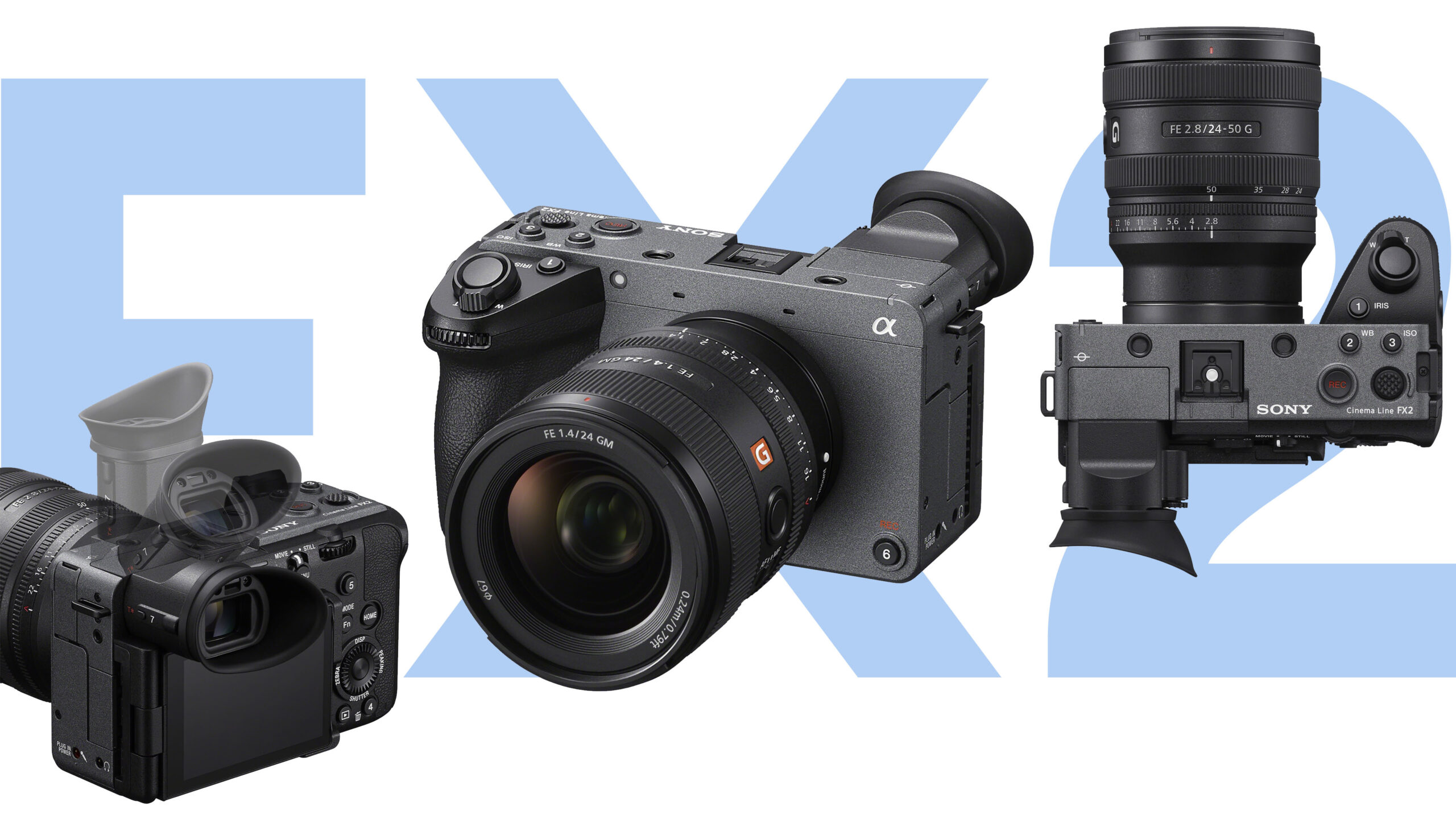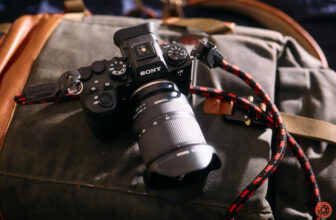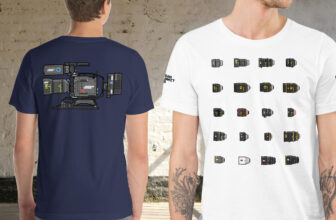
Check out our latest products

After the FX9, FX6, FX3 and FX30, Sony has announced another iteration of the successful FX compact cine line – the Sony FX2. Like its older sister, the FX3, this camera is essentially a rehoused Alpha camera, in this case, the popular a7IV. The FX2 uses a 33 Megapixel sensor, somewhat comparable to the one found in the a7IV (though no official confirmation on the matter). Most still and video capture imaging features are shared between the FX2 and a7IV, while most physical attributes are shared with the FX3 and FX30.
Let’s start with some of the key specs of this camera.
- Sensor and Resolution: 33 Megapixel sensor capable of oversampled 4K (7K capture at up to 30P) and 4K 60P (S35 crop).
- Recording Options: 4:2:2 10-bit recording with S-Log and S-Cinetone options, and external 16-bit raw video option via HDMI.
- ISO and Dynamic Range: Dual-gain architecture with Base ISO settings of ISO800 and ISO4000 for S-Log shooting, capturing 15 stops of latitude.

Sony FX2 gets 4K S35 crop mode
The FX2 boasts a 33 Megapixel sensor capable of oversampled 4K, coming from a 7K capture at up to 30P./ It can also record up to 4K 60P, albeit from an S35 (APS-C) crop. To put that in a different context – Both the FX3 and FX6 can’t record 4K from an S35 crop, since the 12 Megapixel sensor can’t resolve that much. This makes the FX2 unique among its brethren, capable of both full frame and S35 4K recording options. 120P FHD is also available. 4:2:2 10-bit recording is available across the board with S-Log and S-Cinetone options (for both video and stills), for maximal versatility and color depth, and if you’d like an additional stretch, there’s also an external 16-bit raw video option, via the HDMI type A port. The BSI sensor uses a dual-gain architecture with Base ISO settings of ISO800 and ISO4000 for S-Log shooting, capturing as much as 15 stops of latitude (as per Sony’s statements – we will put the camera through our Lab Test once we get access to a production unit).

Tiltable EVF
Aside from the excellent FX3 body we all know and like, the new FX2 adds one unique hardware feature, rarely seen across the market (and that’s a shame): A tilting 3.68 million dots EVF. The Sony FX2 may come across as a mix between the FX3 and the a7IV. If you are familiar with those, you probably think you have the new FX2 all figured out, but the decent way to look at it is to review it for what it is: a new camera. Let’s dive in and figure out what Sony has done here. Let me tease by saying that a camera is much more than its spec list, and rehousing may be way more influential than the usual feature evolution we usually see.
The unusual suspect
At first glance, the a7IV is hardly the obvious candidate for being transformed into a cine FX camera. In the vast Sony Alpha lineup, it’s arguably the least video-oriented tool. A 33 Megapixel sensor yields excellent results for stills and offers nice-looking oversampled 4K, but it struggles with fast read speed, as can be seen in our lab test. Along with the risk of a rolling shutter effect, read speed limits slow motion capabilities to 4K 60P from an S35 crop, and 120P in FHD only. While these may seem like major setbacks from a spec-oriented point of view, I’ll argue that they bear significant advantages as well, especially when taking the entire FX line into perspective.

A camera for the 99%
In recent years, slow motion capabilities in 4K and even over 4K have trickled down from dedicated cine cameras to the top end of hybrid cameras, and even to some mid-tier cameras. As nice as it is, a huge chunk of video creation is still done in normal 24-30P speeds. In that regard, the new FX2 offers highly detailed 4K footage, oversampled from 7K. The FX2 also allows for S35 (APS-C) 4K (slightly oversampled from 4.6K), which opens up a plethora of new optical options, limited to FHD on the FX3, as well as a “digital zoom” option if needed. Quite useful, arguably more useful than 4K 120P for some.
I’ll admit – I’d love to see a 7K open gate option for added aspect ratio creativity, but for most cases, sharp 4K output will be more than enough, and will probably outshine the higher tier FX3 in normal capture speeds (while being more affordable). Moreover, the new Sony FX2 does something I don’t recall from any other camera I’ve seen lately – taking a cine-oriented camera and adding significantly better still image capture to it.
A cine camera leaning towards stills
Sony FX2 is a cine camera, first and foremost. With the excellent FX3 design and some cine-oriented features, such as a “BIG6” screen (using the screen to show main image parameters). While no one mistakes it for a still camera, Sony acknowledges the rising need for capable still capture across the industry and incorporates it in the FX2. We’ve all seen still cameras leaning further and further into video and cine, and have seen features originating in still photography trickle up to high-end cine gear, but with the FX2, Sony emphasizes the camera’s high-resolution stills capability in a way I haven’t seen before. The camera even offers Log shooting for stills, for easier integration with your video colors and grading workflow. Visual content convergence is coming (though like the rainbow – the closer we get, the farther it goes).

Ergonomics over specs
Stepping down from the philosophical plane, the FX2 is essentially a rehousing of the a7IV in an FX3 body. While some may consider such a move as cost-cutting motivated, I believe a change in ergonomics is among the most influential upgrades available these days. A pixel here, half a stop of DR there, these evolutions, while not unimportant, can’t match what this rehousing does to a camera.
The way we interact with our gear, making it an extension of our hand and even our creative consciousness, is fundamental to filmmaking. The combination of a7IV specs and FX3 build creates an entirely new camera. The active cooling will allow for a longer recording period with the demanding oversampled 4K, the XLR handle will allow integration of professional audio recording in a small body, and the unique chassis may render cages obsolete due to its various built-in mounting options and I/O ports.
Sony also threw in a useful and rare design feature – a tilting EVF. Once a standard for camcorders, this ability is hard to find among hybrid cameras. One can blame the conservative SLR-inspired design of those, and I’m happy to see Sony adding such a feature, and hope we’ll see other companies adopt it. FUJIFILM has its version on the flagship GFX cameras (requiring an optional accessory), and Panasonic incorporated a tiltable EVF in some older Micro Four Thirds LUMIX cameras, but it’s far from being widespread.
Will the Sony FX2 be the new video workhorse?
I won’t risk gambling on industry trends, but from my perspective, the FX2 occupies a sweetspot between its FX3 and FX30 stablemates, and somewhat above the Alpha hybrids regarding video. It’s a well-specd, well-built video camera. It excels at the standard, normal, and common use cases, and I’ll argue that the FX2 is Sony’s best choice for these. I believe the Sony FX2 will make many videographers, content creators, and filmmakers happy. Be sure to take a deeper look at our additional testing and figure out if it suits your specific needs.
Comparison chart: FX30, FX2 and FX3
| Feature | FX30 | FX2 | FX3 |
|---|---|---|---|
| Sensor | Back-illuminated APS-C size Exmor R CMOS sensor (26M) | Back-illuminated 35mm full-frame Exmor R CMOS sensor (33M) | Back-illuminated 35mm full-frame Exmor R CMOS sensor (12M) |
| Processing engine | BIONZ XR | BIONZ XR | BIONZ XR |
| HFR (4K / FHD) | 4K 120p (QFHD) / FHD 240p | 4K 60p (S35) 30p (QFHD) / FHD 120p | 4K 120p (QFHD) / FHD 240p |
| Recording format | XAVC S / XAVC S-I / XAVC HS | XAVC S / XAVC S-I / XAVC HS | XAVC S / XAVC S-I / XAVC HS |
| Bit-depth / Codec | 10bit 4:2:2, Long GOP, All-I / H.264, H.265 | 10bit 4:2:2, Long GOP, All-I / H.264, H.265 | 10bit 4:2:2, Long GOP, All-I / H.264, H.265 |
| ISO range | 100 – 32000 (50 – 102400 expanded) | 80 – 409600 (expanded) | 80 – 409600 (expanded) |
| Base ISO | 800 / 2500 | 800 / 4000 | 800 / 12800 |
| EVF | NA | Yes (tilt:0°–90°) 3.68M | NA |
| LCD screen | 3.0” / 2.36M | 3.0” / 1.04M | 3.0” / 1.44M |
| Latitude | 14+ stop | 15+ stop | 15+ stop |
| Cinema look / S-Log | S-Cinetone, s709 / S-Log3, HLG | S-Cinetone, s709 / S-Log3, HLG | S-Cinetone, s709 / S-Log3, HLG |
| LUT (Preset / Custom) | 709 (800%), s709 / Yes (User LUT) | 709 (800%), s709 / Yes (User LUT) | 709 (800%), s709 / Yes (User LUT) |
| Log Shooting Setting | Flexible ISO / Cine EI / Cine EI Quick | Flexible ISO / Cine EI / Cine EI Quick | Flexible ISO / Cine EI / Cine EI Quick |
| Autofocus | Fast Hybrid AF (no AI processing Unit) / Eye-AF (human, animal, bird) / Tracking | Fast Hybrid AF (AI processing unit) / Eye-AF (human, animal, bird, insect, car, train, airplane, auto) / Tracking | Fast Hybrid AF (no AI processing Unit) / Eye-AF (human, animal [still only]) / Tracking |
| Stabilization (Body /Application) | Yes 5-axis (Active / Standard) 5.5 stops / Yes | Yes 5-axis (Dynamic active / Active / Standard) 5 stops / Yes | Yes 5-axis (Active / Standard) 5.5 stops / Yes |
| Handle / Grip / Screw | XLR handle / – / ¼-20 UNC x4 | XLR handle / – / ¼-20 UNC x3, M3 x1 | XLR handle / – / ¼-20 UNC x4 |
| UVC / UAC | Yes | Yes | NA |
| Active cooling | Internal fan | Internal fan | Internal fan |
| Media | CFexpress Type-A / SD x2 | CFexpress Type-A / SD x1 + SD x1 | CFexpress Type-A / SD x2 |
| Battery | NP-FZ100 (16.4Wh) | NP-FZ100 (16.4Wh) | NP-FZ100 (16.4Wh) |
| Dust & moisture resistance | Yes | Yes | Yes |
| Shutter | Electronic shutter | Mechanical, electronic shutter | Mechanical, electronic shutter |
| Continuous shooting speed | NA (single shooting) | 10 fps | 10 fps |
| Flash control | NA | Sony α system flash, flash sync speed 1/250 sec. | Sony α system flash, flash sync speed 1/250 sec. |
| Size and weight | 129.7 x 77.8 x 84.5 mm / 646 g | 129.7 x 77.8 x 103.6 mm / 677 g | 129.7 x 77.8 x 84.5 mm / 714 g |
Price and availability
The Sony FX2 will be available for $3,099.99 with an XLR handle or $2,699.99 for the body only version.
Do you see the Sony FX2 as an option, or will you stick with the tried-and-true FX3 for the faster options? Let us know in the comments.

![[2025 Upgraded] Retractable Car Charger, SUPERONE 69W Car Phone Charger with Cables Fast Charging, Gifts for Men Women Car Accessories for iPhone 16 15 14 13 12, Samsung, Black](https://i1.wp.com/m.media-amazon.com/images/I/61SaegZpsSL._AC_SL1500_.jpg?w=300&resize=300,300&ssl=1)



![[True Military-Grade] Car Phone Holder【2024 Stronger Suction & Clip】 Universal Cell Phone Holder for Car Mount for Dashboard Windshield Air Vent Long Arm Cell Phone Car Mount Thick Case,Black](https://i2.wp.com/m.media-amazon.com/images/I/715PBCuJezL._AC_SL1500_.jpg?w=300&resize=300,300&ssl=1)
![[エレコム] スマホショルダー ショルダーストラップ 肩掛け ストラップホールシート付属 丸紐 8mm P-STSDH2R08](https://i3.wp.com/m.media-amazon.com/images/I/51BMFf06pxL._AC_SL1500_.jpg?w=300&resize=300,300&ssl=1)







